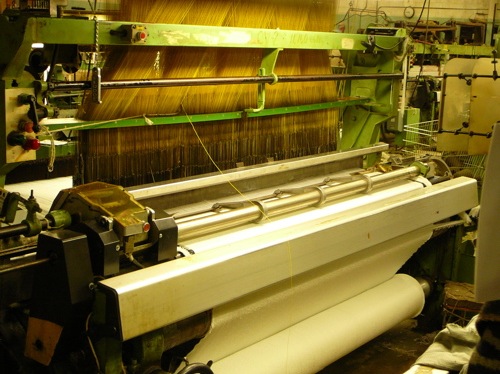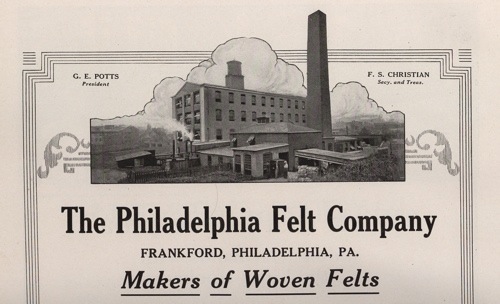
11,700 threads are woven together on this loom, controlled by double Jacquards (2007).
HARRY LONSDALE - CHURCHVILLE FABRICS
© Torben Jenk,
2007.
In 2007, Lonsdale and his
dedicated staff are some of the few survivors of
Philadelphia’s textile industry. Production for the
mass market has moved overseas, using cheap labor and
threads, often including polyester, which costs one third
that of nylon. American weavers face other challenges,
including the weak value of the dollar to other
currencies which has driven up their cost for wool, today
supplied mainly from Australia, New Zealand and South
Africa. On our
tour Harry Lonsdale will
demonstrate various weaving and finishing operations for
us, then share his observations of the contemporary
textile market.
“Wool is a most amazing
fiber” exclaims Harry Lonsdale, a third generation
weaver and felter. “It is resilient, strong,
polishes, wicks moisture, insulates heat and sound,
absorbs shocks, resists abrasion but does not rot, burn
nor conduct electricity.” Through understanding
these characteristics, hands-on technical savvy and by
serving specialty markets, Lonsdale and his dedicated
staff have produced an extraordinary range of products
made from wool, felted and woven.
Lonsdale continues
“Felt surrounds us. Felt held the ink in printing
calculators. Felt seals revolving doors. Felt is used on
countless industrial feed rolls. The furniture industry
uses felt as backing to extend the life of their
expensive wide carriage sand belts. They also use felt to
burnish table tops. Felt also protects lamp bases from
scratching those fine surfaces.” Lonsdale estimates
he produced over 5,000 different die cut parts from felt.
The
military purchased about 60% of Lonsdale’s
production in the 1980s, mainly felt which was used to
subdivide and seal ammunition boxes, preventing sparks
from metal to metal contact. “Unscrew the detonator
pin from the body of a grenade and you will find a small
felt disk... But after the NASA Shuttle Challenger
exploded [soon after launch in 1986] the military
specifications became too cumbersome. It’s no fun
making felt conform to specifications of a thousandth of
an inch.”
Lonsdale produces contract
upholstery for hotels and offices, designed by others and
in house but his desk is covered with written requests
stapled with fabric swatches from companies that supply
authentic-specification parts to restore classic
automobiles. Consider the 1930s era weather seals known
as “windlace,” rubber tubes wrapped in fabric
with a flange for tacking; made from cotton they quickly
rotted. Real enthusiasts and judges at classic car
competitions look at these small details to assign points
and determine “best in class.”
Cotton was also used in auto
upholstery. Now worn out from excessive use and its
tendency to absorb perspiration, Lonsdale has woven over
500 different reproduction fabrics. “Studebaker
offered about a dozen different fabrics each year. Here
is a swatch from a 1950 Olds, notice the nylon. Look
here, metallic threads were used a lot from ‘55-59,
often with Mylar, a fine aluminum thread. And it’s
not just for restorations of the well known cars like the
‘55-57 Chevy Belair and Nomad which have become so
expensive. I now get requests for upholstery for the Nova
and Falcon.”
Lonsdale supplies another
fabric to history. In 1998, twenty thousand Union and
Confederate re-enactors gathered in Gettysburg for the
135th anniversary of the disastrous infantry assault
known as Pickett’s Charge which ended Lee’s
campaign into Pennsylvania. For the first time since 1863
there were enough Union and Confederate soldiers for a
complete one-for-one re-enactment. A further one hundred
thousand people paid to watch.
Modern suppliers to this
market often call themselves “sutlers,” the
term for an army camp follower who peddled provisions to
the soldiers. Lonsdale says “loads of crap uniforms
sell for $200 but their inferior fabrics wear out
quickly. Many original Civil War uniforms survive in
superb shape, a testimony to their original design,
superb fabrics and craftsmanship. We weave fabric for
Charles Childs who has done loads of research. A great
guy to do business with too.”
Childs credits his interest in re-enacting to his father
and uncles who took him to the centennial commemorations
of the Civil War when he was only eleven. Childs spent
much of his career “working as a production guy for
a modern dress manufacturer” but his hobby was
researching Civil War uniforms. At the National Archives
Childs found the US Army Quartermaster Manuals, compiled
during the Civil War but never published. Therein are the
most complete and exacting specifications; Childs
concentrated on the uniforms, blankets and tentage. In
the mid 1970s, seeking authentic cloth, Childs started to
weave his own fabrics, producing about one yard per hour,
but the “finishing” was even more time
consuming.
Wool shrinks and sets when dampened and shaken, a quality
frustrating to anyone who has thrown their sweater from
washer to dryer. The woolen industry captured that
tendency to create heavier weight cloth, to obscure the
weave, to improve the lustre, handle and finish. One
hundred years ago this “scouring, fulling,
sponging, decating and shearing” was subcontracted
to specialist firms. Childs says “I looked around
for years. Lonsdale has all those weaving and finishing
skills, and the equipment to recreate quality 19th
century fabrics on a commercial scale.”
With Lonsdale’s fabrics, Childs went full time into
making Civil War uniforms under the name
County Cloth. 6
Unable to meet
the demand he offered kits, fabrics and patterns
(developed from his close observation of authentic
uniforms and his tailoring skills). Childs says that
his customers “want the best stuff, properly
tailored from the best materials, not just sewn from
mill ends bought by the pound.” Few recognize
that a uniform constructed to original specifications
will wear well for decades while cheap imitations
might survive only a year—a costume rather than
a uniform. Sleeping in the rain and marching around
the battlefield is sure to shrink that inferior
garment, a sartorial hazard, particularly revealing if
in the trousers.
Walk into Lonsdale’s
workshop and you might find him repairing a thread on his
double-headed Jacquard loom which “can weave up to
11,600 threads with a 7-1/2 inch repeat. I could write
the Declaration of Independence in fabric.” How
does anyone learn all these skills? Lonsdale says “I am the
third generation in America but it is likely that my
grandfather was descended from a long line of weavers
since that was the major activity in Bradford, England,
where he emigrated from in 1893 at age 18.” [The
textile industry in Bradford stretches back to the 13th
century and it was renowned for the ‘Bradford
system’ of weaving worsted cloth. The essential
feature of a worsted yarn is straightness of fiber, in
that the fibers lie parallel to each other
].
Lonsdale’s grandfather lost his first textile
business during the Depression but later established the
“Lonsdale Worsted Company.” Harry worked with
his father and grandfather at Lonsdale Worsted until it
went out of business in 1974.

Harry Lonsdale
then went to work for Philadelphia Felt, owned by the
Putney family and operated by Bob Putney, Jr.
Philadelphia Felt produced lots of paper making
felts—“we would run over a mile a
minute”—but the demand for ever wider rolls
required the investment of millions of dollars in new
equipment, a risk the Putney family decided not to take
so Philadelphia Felt closed in 1981. Lonsdale bought all
the textile equipment from Philadelphia Felt, nothing
related to making paper felts. In 1983 he bought all the
customers, equipment and real estate of Quaker Felt. He
sold Quaker Felt in 2004 and operates under the name
Churchville Fabrics.